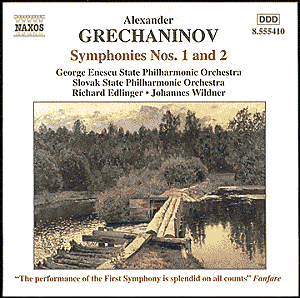Alexander GRECHANINOV (1864-1956)
Symphony No. 1 in B Minor, Op. 6 (1894)
Allegro non troppo
Andante sostenuto assai
Molto vivace
Allegro spirituoso
 George Enescu State
Philharmonic Orchestra/Edlinger George Enescu State
Philharmonic Orchestra/Edlinger
Symphony No. 2 in A Major, Pastorale, Op. 27 (1909)*
Pastorale
Andante
Scherzo
Finale
 Slovak State Philharmonic
Orchestra/Wildner Slovak State Philharmonic
Orchestra/Wildner
Rec. 1988 in Bucharest; and 1989* at the House of Arts, Kosice, Slovakia
 NAXOS 8.555410 [68.22] NAXOS 8.555410 [68.22] |
 |
Crotchet
AmazonUK
AmazonUS
Amazon
recommendations
Alexander GRECHANINOV was born in Moscow in poverty yet prospered
at school where he sang as a soloist in the chapel choir and began piano
lessons at 14. In 1881, when 17, he entered the piano class of Kashkin at
the Conservatory in Moscow and in 1885 became a pupil of Safonov, taking
lessons from Taneyev and Arensky. In 1890 he moved to St Petersburg where
a scholarship at the Conservatorium allowed him to study under Rimsky-Korsakov.
His first significant success was a Concert Overture (1892). The year 1894
was a prolific one for he wrote both his first String Quartet and his first
Symphony. At the time of the Russian Revolution (1917) he left Russia for
the safer shelter of London and Prague. In 1946 he became an American citizen
and died in New York.
In Grechaninov's Symphony No. 1 in B Minor there is skilled use of
Russian thematic material with a complexity of scoring which is far removed
from the simplistic crudeness of composition adopted by the nationalistic
Russian composers of the period.
A strong Russian subject opens the Allegro non troppo which is heard
from the strings. A lightly contrasting second theme is then introduced with
change of key and tempo, reminding one of Tchaikovsky. The romantic and dreamy
Andante introduced by cellos and basses gives a contrast of mood and
feeling which is strengthened by violas, whilst the harp continues to carry
the rhythm. The ending of this movement runs into a Molto vivace which
is characterised by a springy and energetic rhythm held by violas whilst
the violins carry the main theme. An Allegro spirituoso provides the
finale: a powerful opening runs into a sweeping theme which gathers momentum,
and is punctuated by a hunting motif before leading us to a charming conclusion.
Certain elements of composition identify this work as 'modern' for its time.
The Symphony No. 2 in A Major (Pastorale) was written 15 years
after the first. By now contemporary Western influences have crept seriously
into Grechaninov's style.
In the opening Pastorale an unexpectedly ominous figure opens the
work, but this soon fades and we settle into a busy yet lyrical section of
varying mood which is rather uncharacteristic of its Pastorale
title. The Andante in C sharp minor has a first lyrical
theme presented by solo clarinet with syncopated string accompaniment before
the horns join in with a subsidiary element. An energetic middle passage
is heard before we revert to the gentler Andante theme again. An ebb
and flow so characteristic of Tchaikovsky adds to the emotional strength
of the movement. This mood is broken by the Scherzo which immediately
follows. A rippling and energetic opening leads into an oboe solo which gives
us a feeling of space and Russian countryside. A second slower subject provided
by the strings gives the impression of waving wheat fields and meandering
rivers before bringing one back to the first subject again. The Finale
seems to move further away from the original tonality, in a movement
of rich enough variety but here the orchestra is handled with assurance and
good use is made of the wind, as learned from his old tutor, Rimsky-Korsakov.
This disc is a reissue of a recording which first appeared as a Marco Polo
release in 1989.
The recordings are well mastered and the two orchestra play with energy and
commitment. The Slovak State Philharmonic Orchestra plays less competently
however, marred by an occasional out-of-step run by violas, a sluggishly
attacked chord and faltering horn.
The disc carries good notes on the composer and brief notes on the Symphonies
in English, French and German.
Raymond Walker

